Home / Guides / Living & Lifestyle / How to go Vegan
How to Go Vegan
A step-by-step plan to transition to an entirely plant-based, nourishing, vegan lifestyle while keeping traditions and a budget.
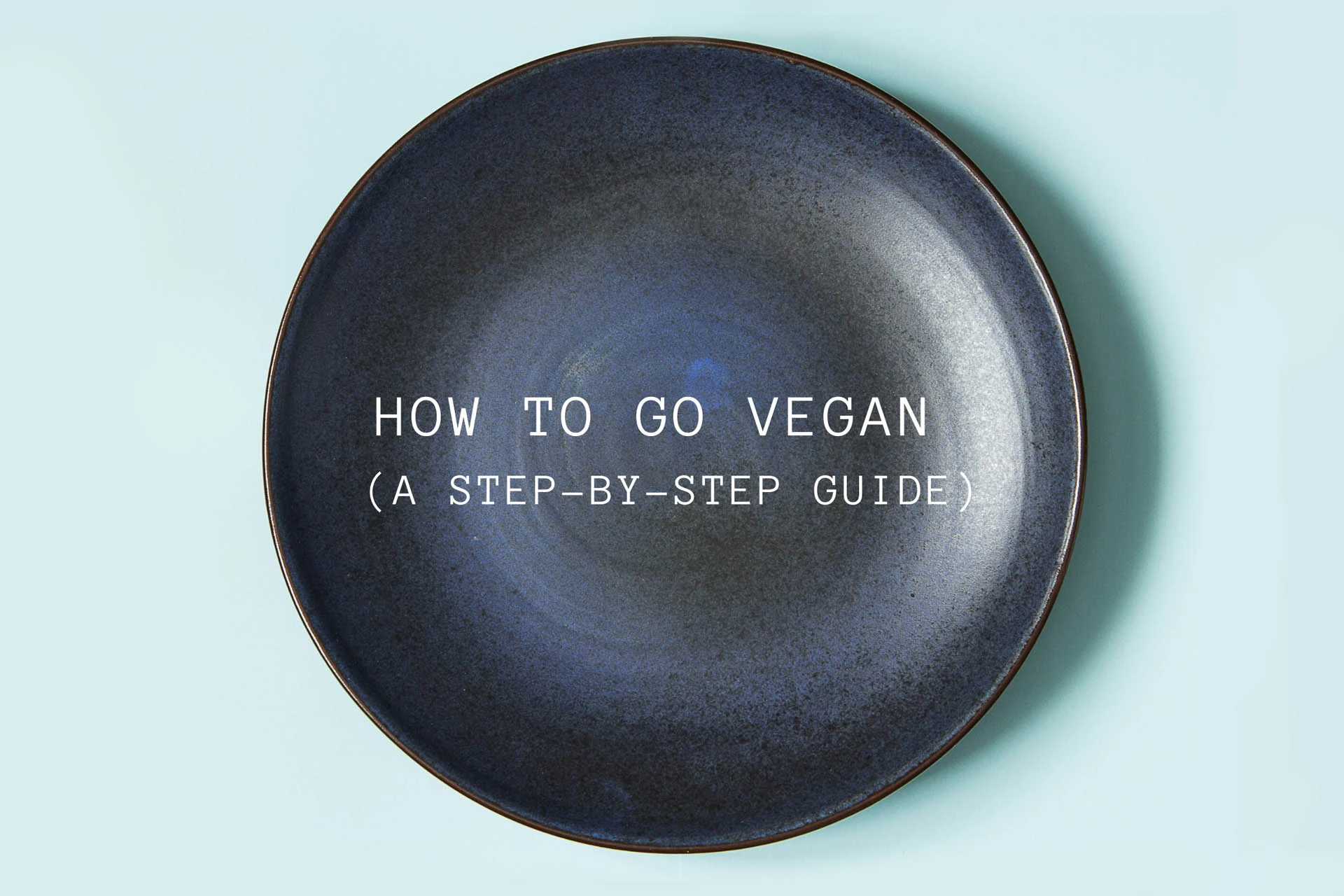
Published: January 2020
Last Update: January 2023
Reading Time: 21 minutes
Do you have questions about veganism?
Are you looking to become vegan but need help knowing where to start? Maybe you're a new vegan who isn't sure if you should take supplements (you should) or how to put together a healthy and nourishing meal. Perhaps you need some advice on fine-tuning veganism so that it's less complicated and, more importantly, more doable for the long haul.
You're not alone. I've had these questions too.
I went vegan in 2005; since then, I've become an expert at vegan living. Navigating our largely non-vegan world is my superpower: I can spot an animal-based product on an ingredient label faster than you can say hummus. That's why I put together this guide. It has tips, tricks, recipes, and more than a few vegan living hacks I've learned over the years.
Let's dig in.
QUICK NAVIGATION

Standing at the start of the future / Source
First Steps / Vegan Food / Costs / Nutrition / Beyond Food
1. First steps
You’ve decided to go vegan, now what? Here are some practical first steps.
Start here
You’ve done the research. You discovered why veganism is better for animals, humans, and the planet, so you decided to go vegan.
Now what?
Frankly, there is no one set-in-stone way to start becoming a vegan. Some people will be able to transition overnight with little trouble. In contrast, others need the ease of incremental changes that step methods provide.
Choosing a method that makes the most sense for you is essential.
The Step Method
One tried and tested method of transitioning into a vegan lifestyle is by gradually eliminating animal-based foods while at the same time increasing the number of plant foods.
Then, once that’s finished, work through the less obvious animal-derived ingredients and products in everyday life. As you complete one step, move on and continue learning and expanding into the next.
This stepped approach of removing and replacing products can help ease you into the transition with feelings of abundance rather than deprivation.
A sample plan
This simple approach to living vegan could look like this:
- Step 1: Stop buying animal products and products tested on animals.
- Step 2: Clean out or use up non-vegan pantry and fridge items.
- Step 3: Clean out animal-based fabrics from your closets and dressers. Donate clothes as appropriate.
- Step 4: Remove obvious animal products left anywhere in the house.
- Step 5: Once non-vegan health and beauty products are gone, replace them with vegan and cruelty-free versions.
And so on.
Feel free to set time limits if you want. Allow yourself several weeks to use up non-vegan pantry items, for example. Or, if you’d rather, don’t set any time limits.
It’s up to you.
Important Note About Replacing Non-Vegan Items
Some people remove these items immediately, whether through donations or giving them to someone they know. While others will continue to use them until their useful life is over and then replace them with vegan versions.
Replacing these items can be costly, do the best you can with the resources you have available. There is no right or wrong way to transition.
Advice from the vegan community
The step method outlined above isn’t the only option for transitioning into a vegan lifestyle. So, what other ways does the vegan community recommend?
Let’s take a look at what some more vegans have to say.
- In a post about going vegan, health blogger Luke Jones suggests writing down your reasons for going vegan and posting them on the fridge or as an alert on your phone will help make veganism stick.
- While Matthew Ruscigno, MPH, RD, believes a good way to start is by eating more of the plant foods you already love and eat, often saying, “By focusing on the ones you already eat, you are making changes even before you introduce new foods.”
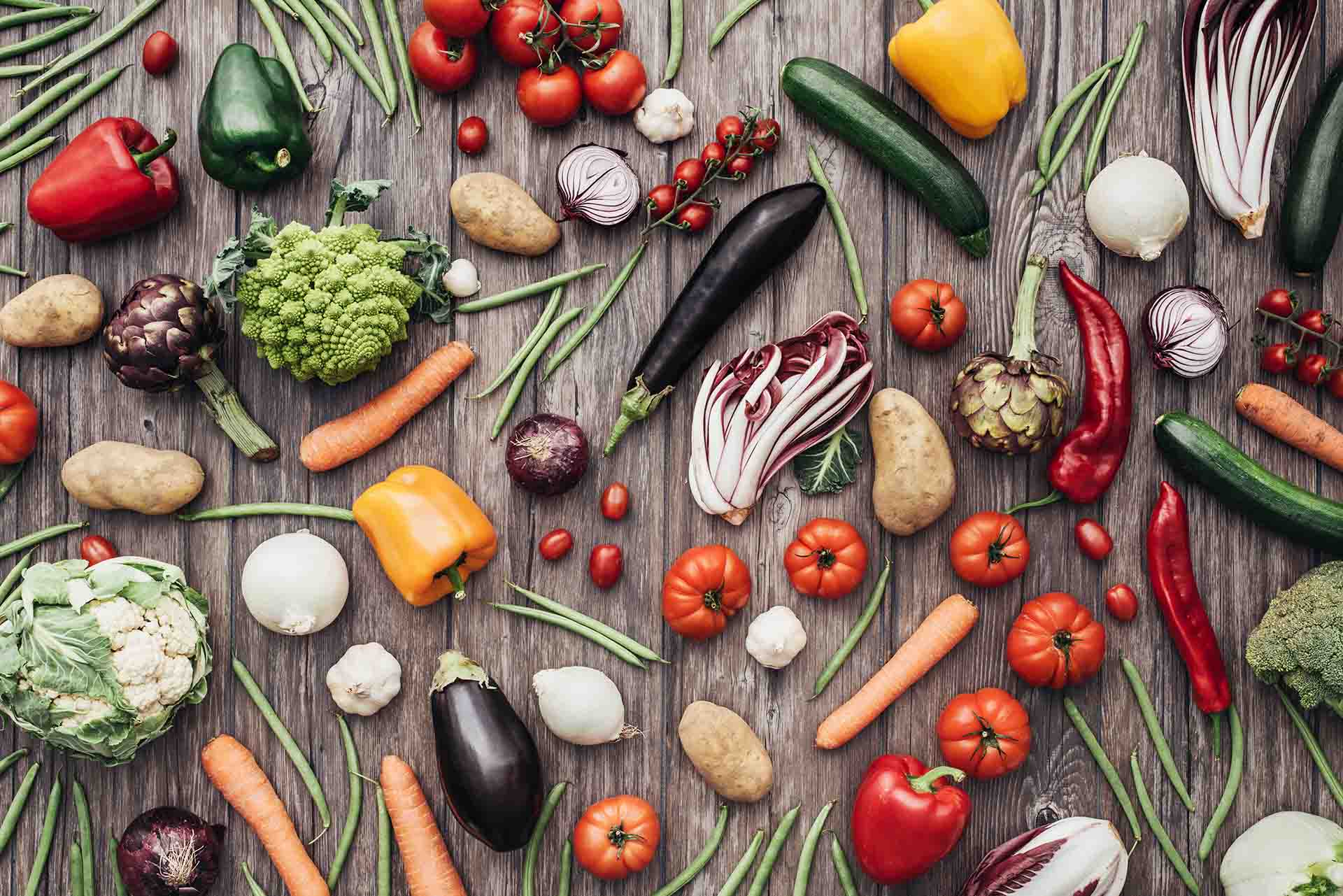
A wide variety of fresh vegetables / Source
First Steps / Vegan Food / Costs / Nutrition / Beyond Food
2. Vegan food
What it is, where to buy it, how to cook it, and recipes to get you started.
How to eat like a vegan
Veganism is more than a diet, but that’s the part that gets the most attention for one simple reason: We all need food to live.
But food is more than that; it’s our family traditions, our treasured memories, and plays a role in our special gatherings. Food is a medicine; it can nourish us.
This guide will show you how to transition to an entirely plant-based, nourishing vegan diet while keeping family traditions and a budget.
And if you are a vegan without an income or a home, I’ve got hacks for you too.
Reading Note
This section is quite big and contains a lot of information, so I broke it into several subsections. At the end of each chapter is a related resource that will offer you the chance to learn more, which I highly encourage you to use.
Non-vegan foods to remove from your pantry and fridge
Let’s start with the easy stuff.
As a vegan, you’ll avoid foods that come from animals like:
- Meats like chicken, pork, and beef
- Seafood like fish, shrimp, crab, and tuna
- Dairy products like eggs, milk, cheese, and ice cream
- Honey
You’ll also want to look out for ingredients made from animal by-products, including these:
- Albumen (egg whites or the protein contained in them)
- Carmine (red coloring from crushed beetles)
- Casein (milk proteins)
- Gelatin (collagen from various animal parts)
- Shellac (confectioner’s glaze from beetle secretions)
- Vitamin D-3 (lanolin from washed lamb’s wool)
- Whey (lactose, protein, vitamins, minerals, and fat from a by-product of the cheese industry)
Other sneaky places you'll find animal products
Here are the foods that you might not think include animal-derived products but do, including:
- Boxed cereals (vitamin D3, milk or milk proteins, gelatin, or honey)
- Marshmallows, gummy candies, and chewing gum (gelatin or beeswax)
- Baked goods like cake and cookies (eggs, dairy, or honey)
- Beer and wine (Isinglass, aka fish bladders)
Don’t let these lists overwhelm you. Like anything else, veganism gets easier with time and practice.
Now, let’s learn about all the plant foods to fill our pantries.
Foods to keep on hand
Most people think being vegan is surviving on salads and vegetables alone, which is untrue.
Plant-based meals include a wide variety of foods like:
- Beans & legumes
- Whole grains
- Fruits
- Vegetables
- Nuts & seeds
Besides those foods, vegans also enjoy the following plant-based staples.
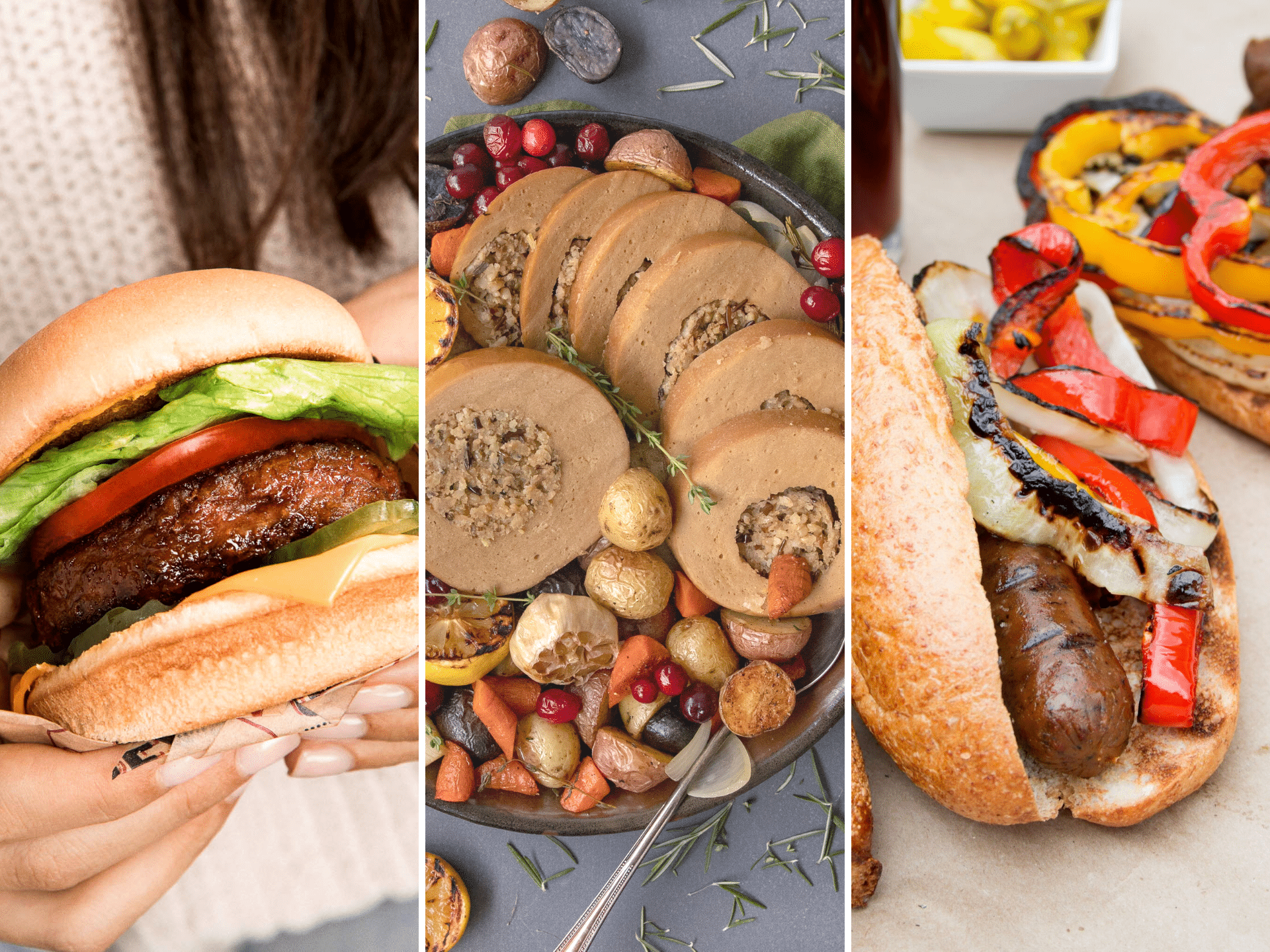
Plant-based burgers, roasts, and sausages are good vegan options / Source
Vegan meats
One of the biggest misconceptions about a plant-based diet is that you are going to give up all the foods you love. Not so! Living vegan doesn’t mean giving up the familiar tastes of your favorite pre-vegan foods.
Were you a fan of thick, juicy hamburgers? Replace them with plant-based versions made from beans, grains, and vegetables. What about sausage or deli meats? Bacon?
There are vegan versions of those too.
Finding vegan meat in stores
Look for brands like Beyond Meat, Gardein, Impossible, Field Roast, or Tofurky in the refrigerator or freezer sections of the grocery store.
Are you looking for something a little more budget-friendly? Making burgers at home can be done at home with a few inexpensive ingredients.
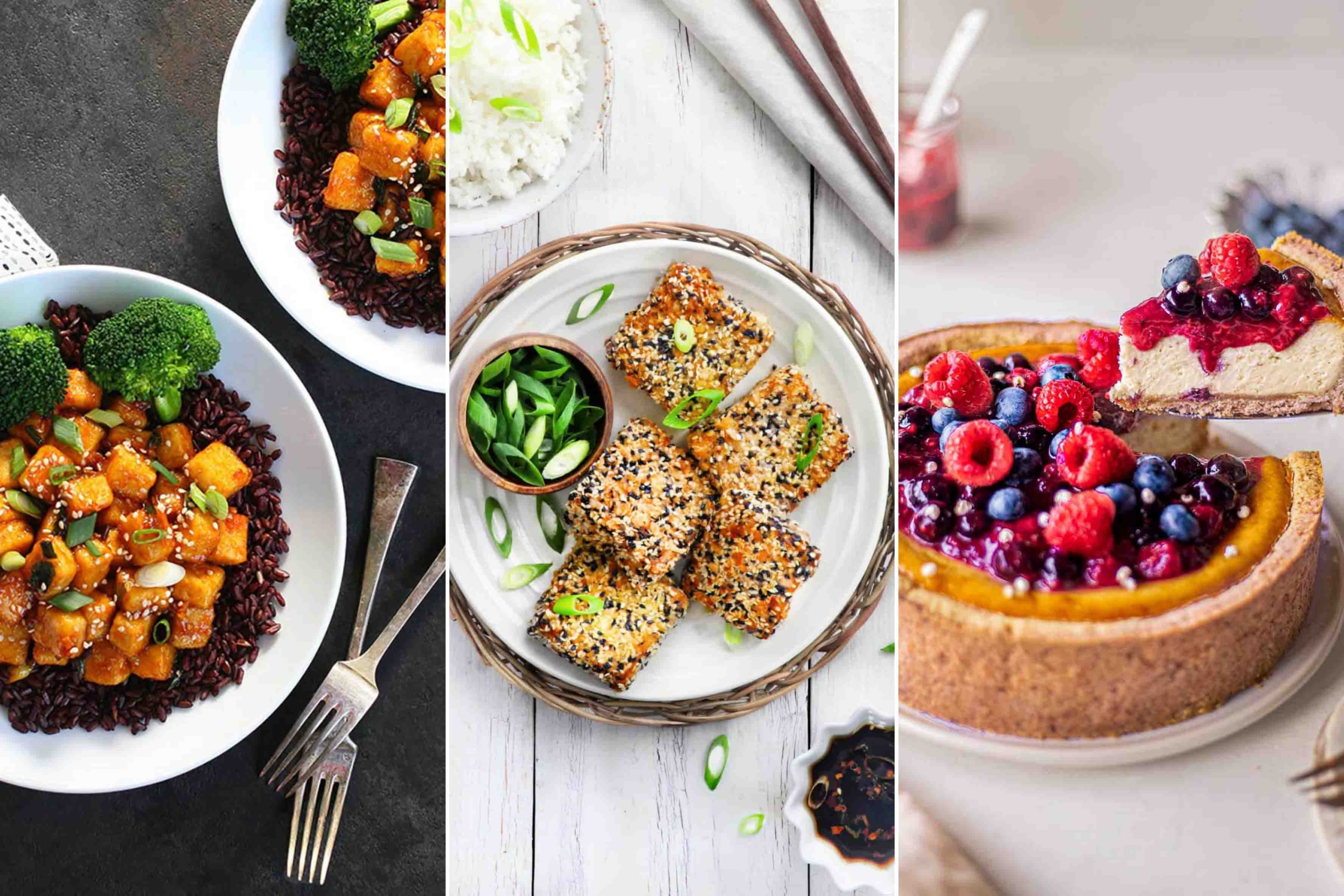
Three delicious vegan tofu dishes / Source
Soy powerhouses: Tempeh and Tofu
If we’re going to have a conversation about vegan staples, we must speak about the top two soy powerhouses: tofu and tempeh.
They’re similar in that they are both soy foods that have been around forever. Frequently used in vegan cooking, tofu and tempeh are favorites because of their versatility and ability to absorb flavor.
The similarities end here.
Tofu is highly versatile
Tofu is made using the same methods and techniques as dairy-based cheese. Tofu’s texture allows it to mimic cream, eggs, mayonnaise, and even some soft cheeses, which makes tofu a go-to for many vegans.
But tofu isn’t without controversy, however.
It has to do with phytoestrogens called isoflavones.
Tofu and soy
The idea is that these soy isoflavones act like the female sex hormone estrogen, potentially increasing the risk of cancer and reducing testosterone levels in men.
But concerns about adverse effects are not supported by the clinical literature available at the time of this writing.
Soy is one of the most researched foods — nearly 2,000 soy-related papers published annually — and based on the health benefits in these studies and the benefits noted in clinical trials, soy is not only safe to eat but also beneficial when eaten in moderation. (1, 2)
Tempeh is a high-protein food
Tempeh, on the other hand, has many nutritional and textural differences from tofu.
Made using a cultural fermentation process using whole soybeans, tempeh has a higher content of protein, dietary fiber, and vitamins than tofu. Between the two, tempeh is a healthier, less processed choice.
And it's just as versatile.
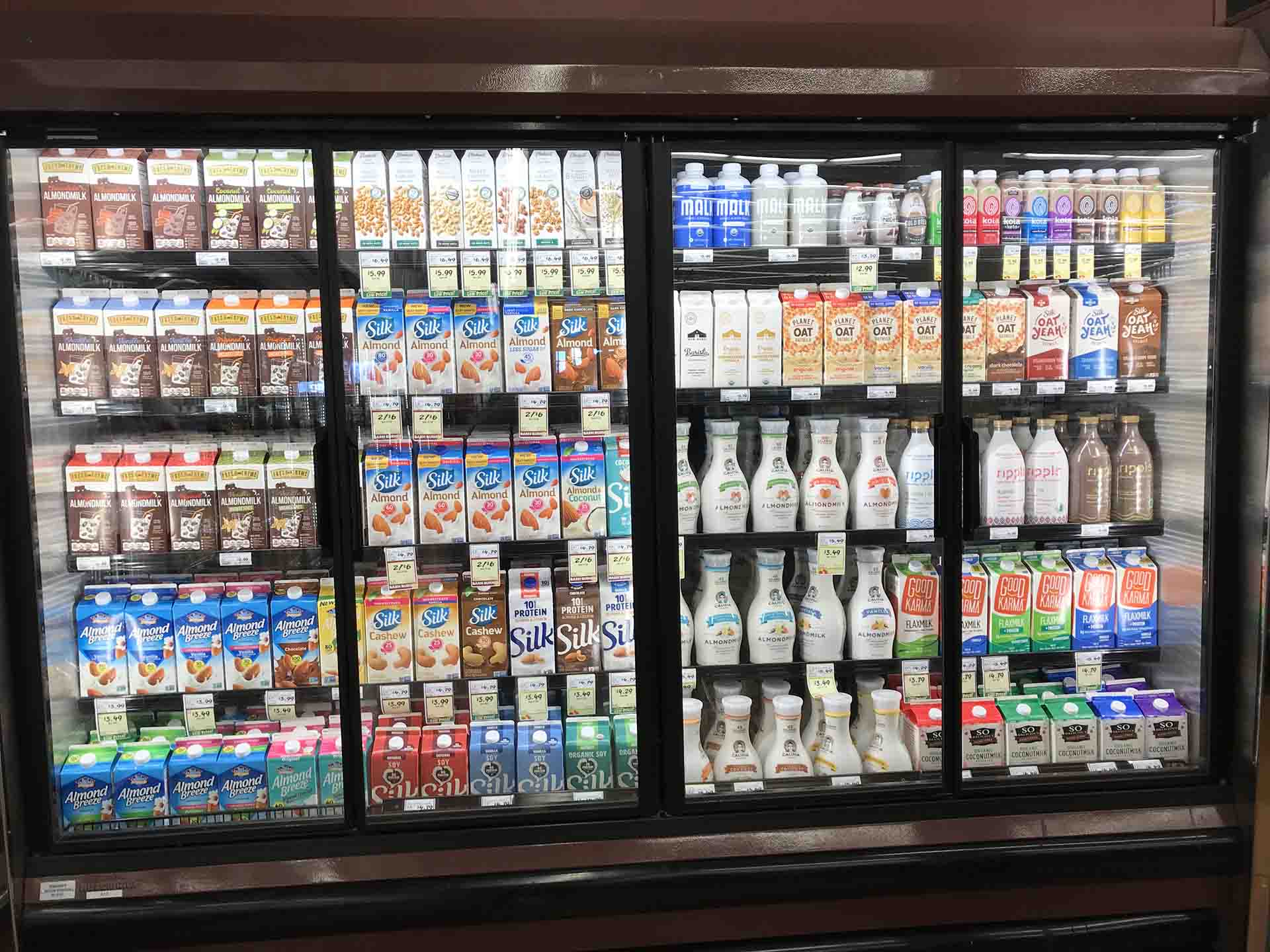
A cold dairy-free case at the grocery store / Source
Dairy-free milk
Replacing dairy-based milk in recipes isn’t complicated, but it does help to know which dairy-free milk will work best in the methods you’re trying to create.
In general, soy milk is an excellent choice as an alternative in any recipe. It’s thick and creamy, just as you’d expect milk. Plus, you can find soy milk in almost any mainstream grocery store, which is why it is my go-to recommendation for plant-based milk.
Oat milk is just as versatile as soy milk and is easily found in grocery stores. Other options include almond, flax, hemp, pea, or macadamia nut milk.
Buying tips
Whichever dairy-free milk you choose, it’s important to remember to buy the unsweetened or original version. Some plant-based milk contains flavors or sweeteners, which can add unwanted sweetness to dishes if you plan to cook with it.
You’ll find dairy-free milk in two places at the grocery store; the refrigerated case as well as in aseptic containers stocked alongside their dairy-based counterparts.
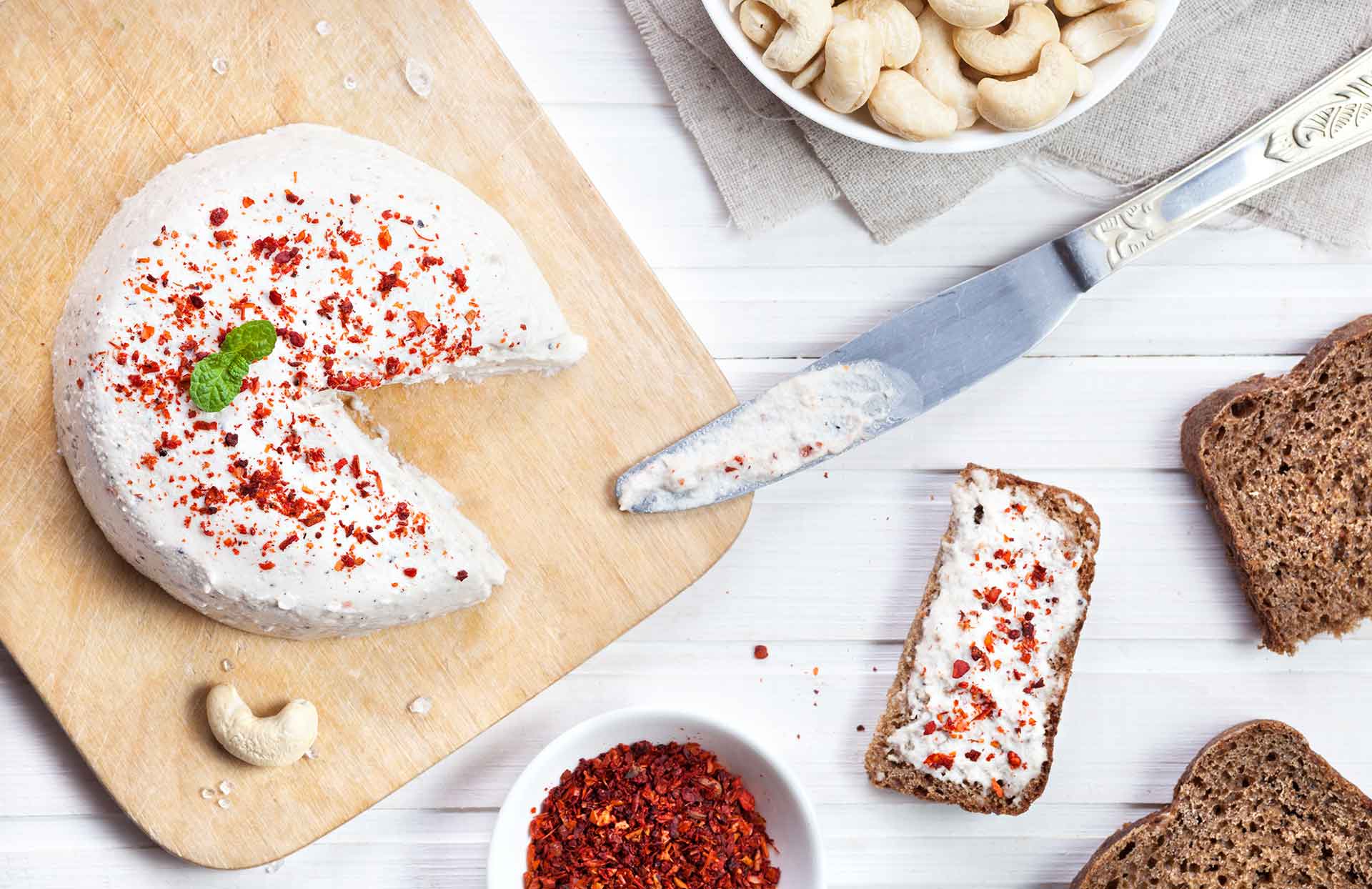
Cheese made from cashews / Source
Vegan cheese
If you can’t imagine how vegans live without eating cheese, I have a secret for you.
We don’t.
But instead of dairy-based cheese, vegans choose cheese made from things like nuts, nut milk, seeds, or even beans. And with so many different types available, you’re sure to find one that you love.
There are a variety of options
Are you looking for melty cheeses perfect for nachos or pizza? Find bags of shredded plant cheeses by companies like Daiya, Follow Your Heart, or So Delicious.
Or, maybe you’re searching for spreadable cheeses like cream cheese? You’ll find delicious options from brands like Daiya, Kite Hill, Treeline, Tofutti, or Violife.
If you’re looking for sliceable blocks of cheese, look no further than Daiya, Follow Your Heart, or Violife. Miyoko’s Kitchen makes a full line of cheeses from shreds to blocks to artisanal wheels.
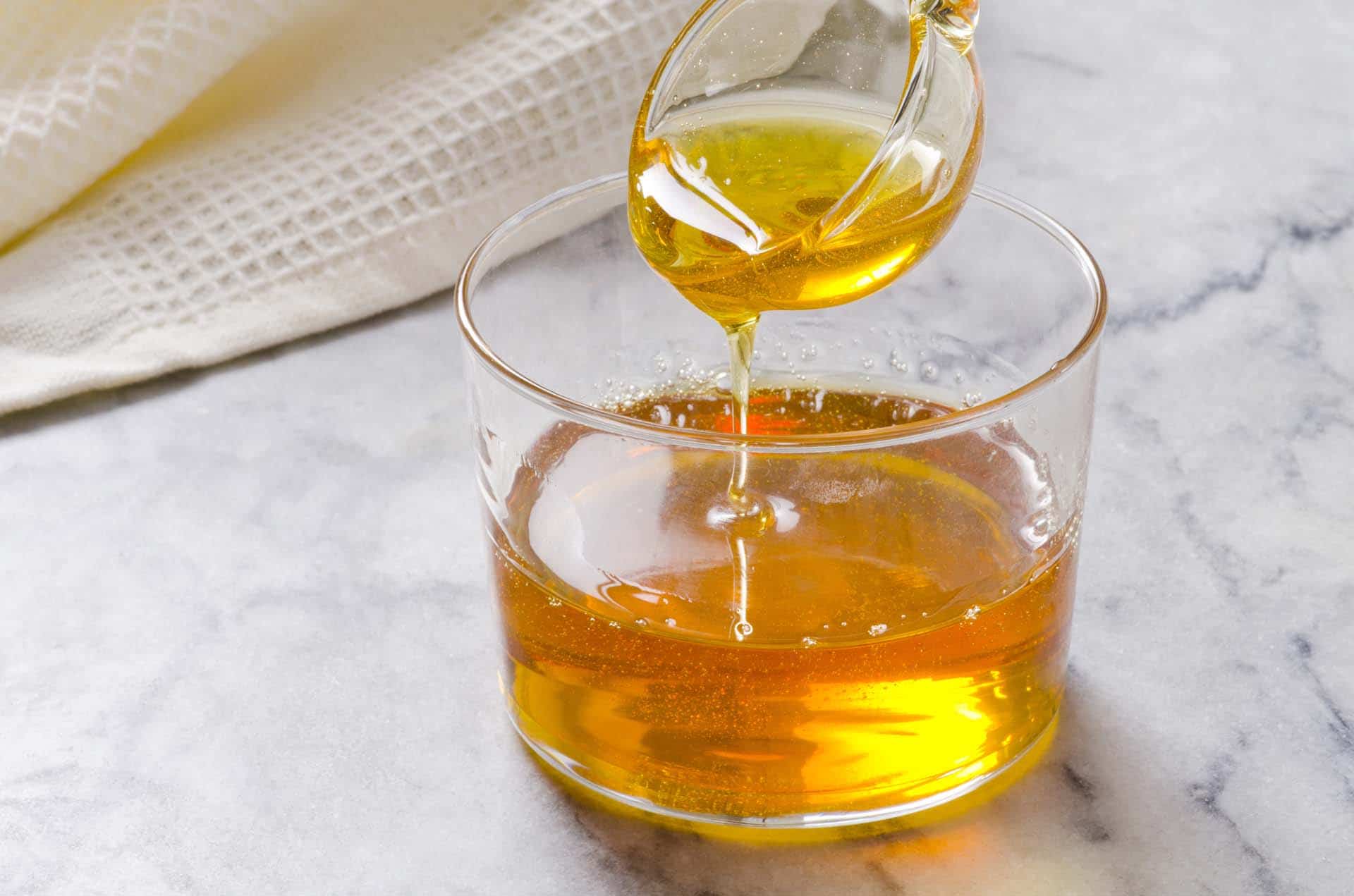
Agave syrup / Source
Vegan sweeteners
It might seem strange to see sweeteners on the list; however, there are two considerations for vegans when it comes to them. First, liquid sweeteners like honey come from bees which prevents it from being part of a vegan diet.
And secondly, bone char sugar. Basically, bone char is bone meal turned into an activated charcoal that the food industry uses to purify sugar.
But like other non-vegan ingredients, finding an alternative is simple.
Sweet options
Here are a few:
- Agave Nectar – Produced from several species of the agave plant, sweeter than honey and tends to be less dense. It comes in various styles that range from dark amber to light, each with its distinct flavor.
- Coconut Nectar – Made from the reduced sap of coconut palms, coconut nectar has a sweet, tangy taste with no discernable coconut flavor.
- Maple Syrup – Yes, the same stuff that goes so great on waffles.
- Barley Malt Syrup – Comes from sprouted barley, roasted and cooked down to a syrup with a malt-like flavor.
- Brown Rice Syrup – Brown rice syrup is a thick sweetener that exposes cooked rice to enzymes that break down starches and turn them into sugars. Once complete, all the “impurities” are filtered out, and all that is left is a thick dark syrup with a caramel-type flavor.
- Molasses – This thick, sweet syrup comes from refining sugarcane or sugar beets into sugar. Like agave, molasses has several varieties and flavors.
Vegan brands
You can also find honey alternatives at health food stores and well-stocked markets.
Look for the following brands:
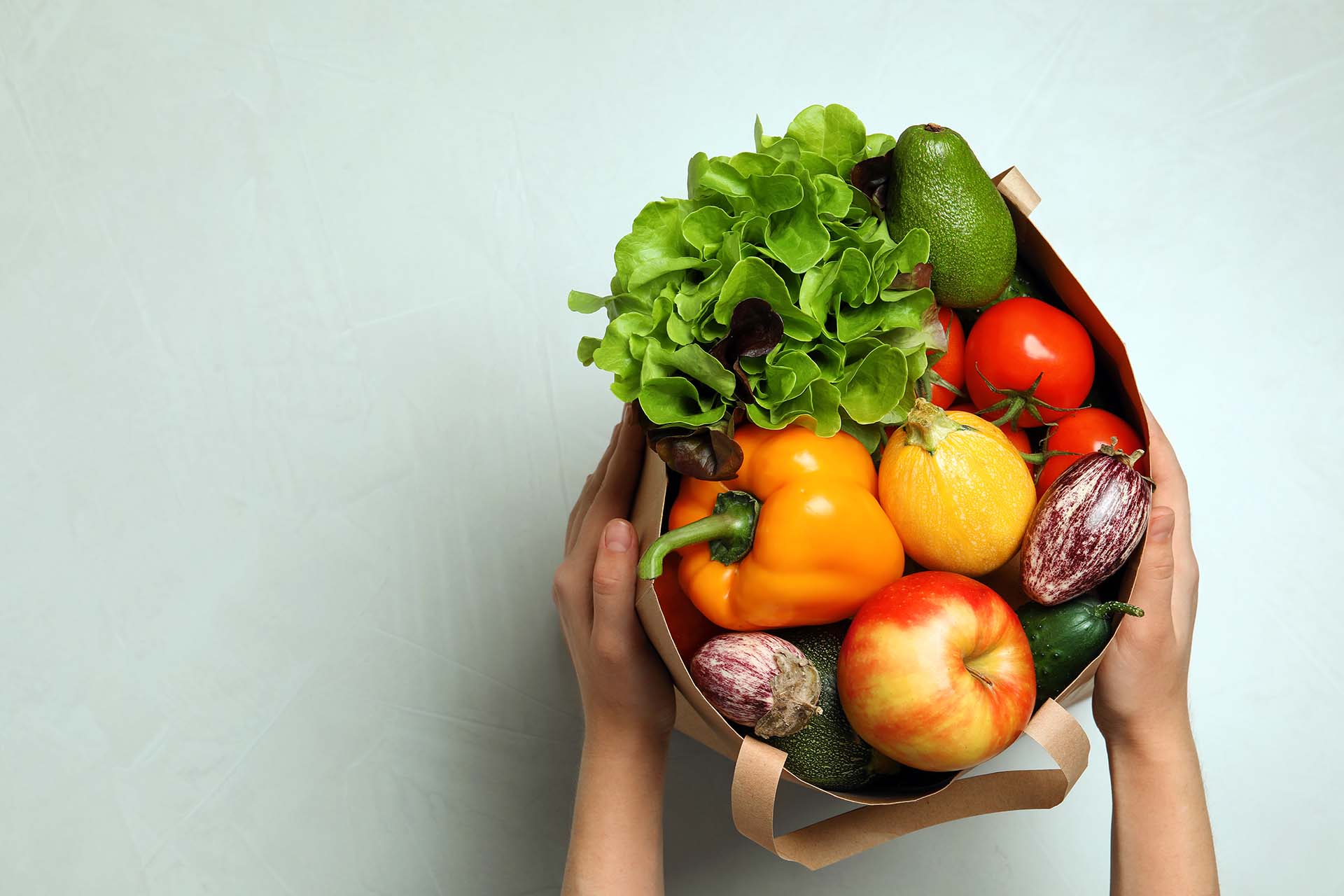
Fresh food grocery haul / Source
First Steps / Vegan Food / Costs / Nutrition / Beyond Food
3. Costs
Is vegan food more expensive? It can be. Let's talk about it.
How to shop like a vegan
It might seem obvious that you’d have to visit a store to purchase vegan products. Still, sometimes it helps to get a general idea of how most grocery stores stock these items.
It used to be that most stores would create a specialty section that housed their entire vegan stock, but that’s not always the case now. You’ll often find plant versions of all your favorite foods right where you’d expect them to be.
So, if you’re looking for plant burgers, you’ll find them alongside non-vegan burgers, for example.
Vegan on a budget
One misconception about vegan food comes up more often than any other; how expensive it can be.
And it’s true, or it can be. Especially true if you’re relying on prepared or processed vegan foods. But it doesn’t have to be that way.
In addition to this website, I also run an animal sanctuary for cats. That is to say, I’m always on a budget, so I know how to stretch pennies.
Here’s how I do it.
Making a budget
The first step to eating an inexpensive but satisfying and nourishing plant-based diet is to create a weekly or monthly food budget. This budget will look different for every family.
Determine your budget by using the following formula:
- Monthly take-home pay is subtracted by fixed costs, other monthly expenses, and savings goals.
The resulting number is the dollar amount available for food and incidentals.
[If you do not have an income, skip to the next section.]
Tips for keeping within your budget
No matter how tight your budget is, these tricks can help make every paycheck stretch a just little further:
- Plan menus and use grocery lists.
- Use coupons and discounts whenever possible.
- Stock up on items when they are on sale (if you can).
- Shop online for items at a discount.
- Shop less often to reduce impulse shopping.
- Buy items like cereals, rice, and beans in bulk.
- Join a monthly Community Supported Agriculture (CSA) to get in-season vegetables and fruits.
- Buy from local ethnic markets or farmer markets.
- Grow your food if you can.
- Learn how to preserve your foods with canning or freezing. Particularly useful when bulk shopping or batch cooking.
More money saving tips
If you regularly buy organic foods, you can still save money. Limit your spending on just those foods that are most prone to contain high levels of pesticides.
The Dirty Dozen list from the Environmental Working Group (EWG) highlights the top twelve foods to contain the most pesticides.
Keep in mind that the peels of foods like avocado and bananas have thick, inedible skins so that they can be bought safely as non-organic.
Budget-friendly resources
The following websites are great for cheap vegan eats:
These money-saving tips and tricks articles from vegans around the web are worth reading and filled with tons of helpful information:
- Vegan Lifestyle on a Budget – I love the section on how to compare prices and make the most out of each shopping trip.
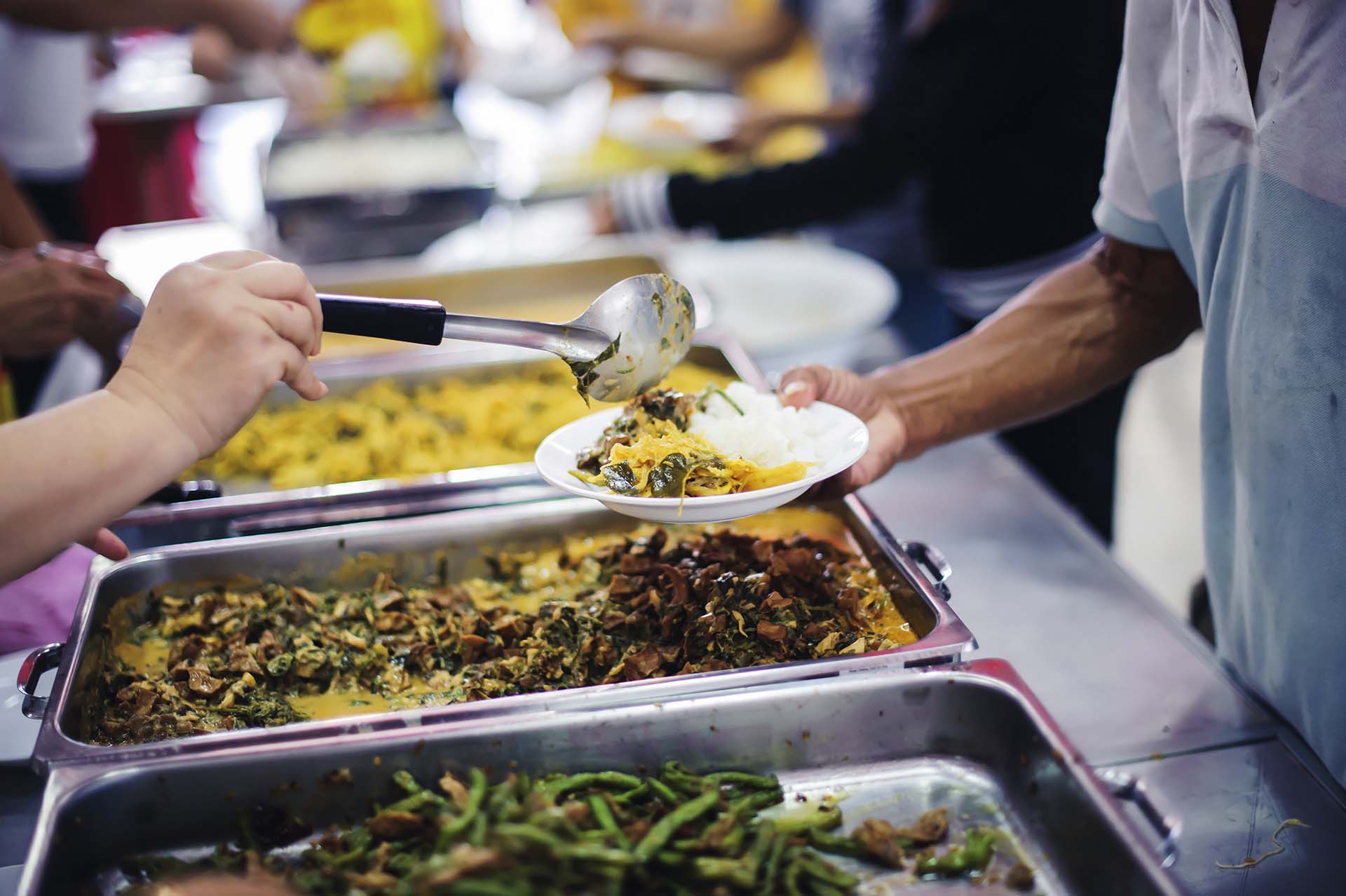
Feeding people / Source
Unhoused vegans with or without income
For those not experiencing these issues, it can be hard to understand why this section is even here. You might think, “the last thing homeless people are thinking about is how to be vegan,” and “there are no such things as homeless vegans.”
But, this is mostly incorrect. Worse, it erases large groups of people and their experiences.
To make veganism accessible, it must be doable for all people living in all situations.
Moving on.
It's not impossible
If you are experiencing housing or income insecurity, veganism can be challenging. But it’s not impossible, however. From clothing donations to food, there are plenty of vegan challenges to navigate.
First, sometimes survival depends on the generosity of others, and vegan options could be limited. Do the best you can in your situation, period.
Stay alive.
Now, let’s talk about vegan eats.
Inexpensive vegan options
Access to income, storage, the ability to heat food, and even the proximity to a grocery store or food market can vary dramatically from area to area.
I’ve put together a list of inexpensive foods in grocers, convenience stores, and gas stations to be the most beneficial. Most come fully cooked; others require nothing more than a cup of hot water.
Some are single-serving for cases where storage isn’t possible, while others can be stored until opened without refrigeration. I’ve also tried to find some foods on the soft side in cases where dental issues are a problem.
Look for:
- Peanut Butter
- Cans of beans, soups, stews, and vegetables like potatoes or green peas
- Ramen
- Prepared tofu
- Bags of carrots
- Nuts or seeds
- Fresh or dried fruit
- Instant oatmeal, rice, or mashed Potatoes
- Fortified non-dairy milk (single serving sizes)
More tips
Check local stores for bulk sections. Sometimes you can find things to cook with hot water like textured vegetable protein (TVP) and soup mixes.
To add flavor, save soy sauce, hot sauce, salt packets, or pepper packets from other meals to help add spice to the next one.
Some grocery stores and bakeries will offer deeply discounted foods (sometimes free) at the end of the day.
You still need B12
One of the biggest hurdles will be finding an adequate amount of vitamin B12.
The easiest way is through supplementation. Generally speaking, you can find a bottle of vegan B12 supplement for $8 – $12 for 90 tablets. If you cannot purchase a supplement, drinking B12-fortified beverages is the next best thing.
Believe it or not, and I checked with a registered dietitian for accuracy on this, Redbull is a good choice because it’s packed with vitamin B12.
Be sure to drink a fortified beverage 2 – 3 times per week if possible.
Free vegan food
It can be hard to find a soup kitchen that serves exclusively vegan food, however, organizations do exist. The following groups serve vegan food. And, they have chapters all across the country.
For a complete directory of soup kitchens in the United States, visit Homeless Shelter Directory.
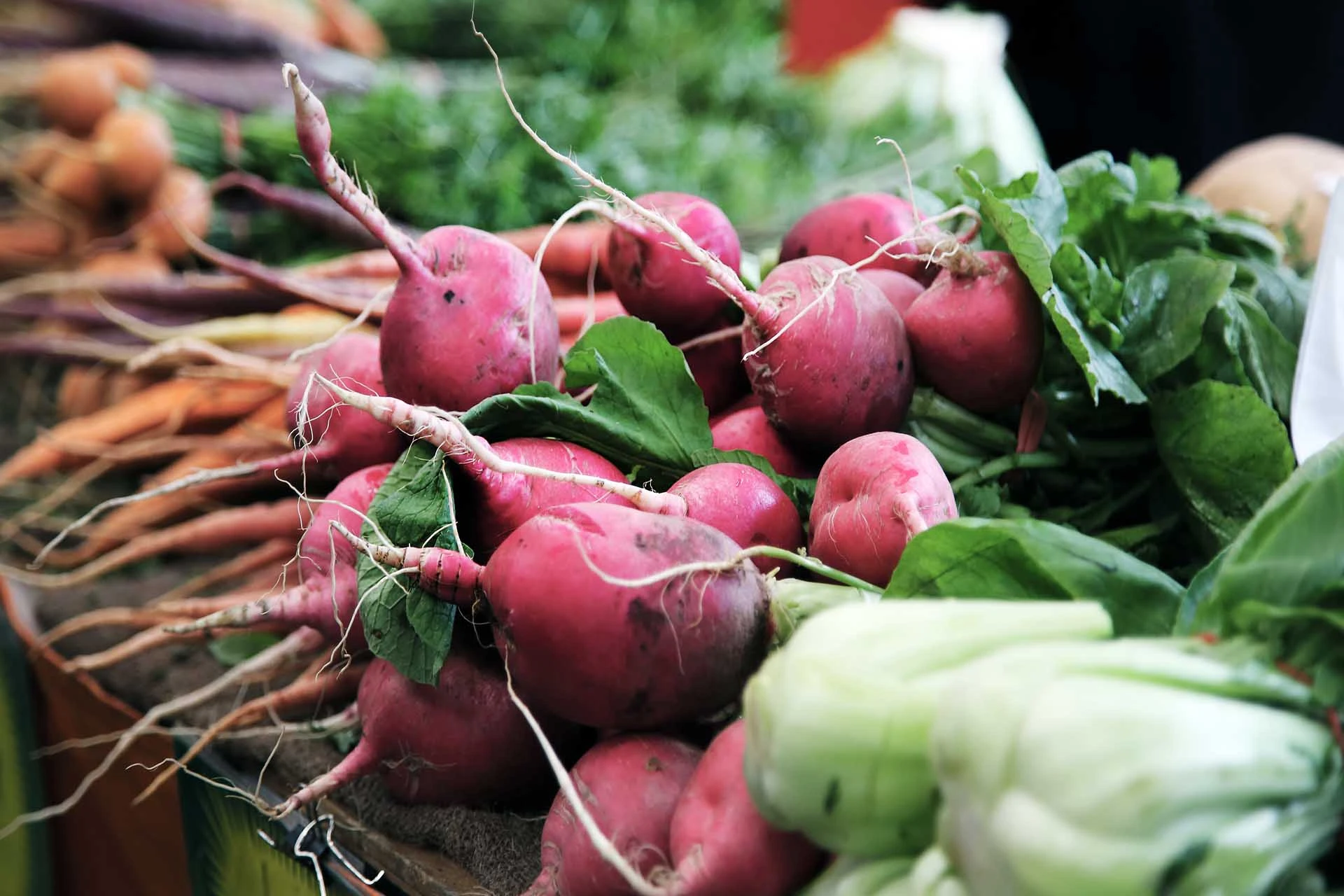
Fresh vegetables at the market / Source
First Steps / Vegan Food / Costs / Nutrition / Beyond Food
4. Nutrition
Is a vegan diet healthy? Absolutely.
How to plan a nourishing vegan meal
I’ve covered a wide variety of information in this guide so far. Having all this information is one thing; the real trick is knowing how to use it.
Now that you’ve removed all of the animals from your diet, what’s left, and how do you build a vegan meal plan?
That will depend on you.
The first rule of building any successful meal plan is to be realistic about what you are comfortable doing. Don’t think you’re suddenly going to become the next vegan home chef if you’ve never cooked before.
Vegan meal ideas
Build a menu that reflects foods you love while adding new foods you want to try.
Breakfast Options: Cereal, oatmeal, toast with nut butter, non-dairy yogurt, polenta, tofu scramble, pancakes, waffles, muffins, bagels (check ingredients carefully), or smoothies.
Lunch + Dinner Options: Soups, salads, sandwiches, wraps, pizza, pasta, stir-fry, tacos, or burritos.
Snack Ideas: Trail mix, bars (fruit/nut, granola, or protein), cut vegetables with hummus, fresh or dried fruit, kale or other vegetable chips, crackers with nut butter or vegan cheese, or popcorn.
Evidence-based nutrition from a registered dietitian
Here’s some real talk: While a well-balanced, adequately planned plant-based diet is perfectly healthful, poorly designed ones can cause nutrient deficiencies.
[Poorly designed non-vegan diets can cause nutrient deficiencies, too.]
The good news is that there are easy ways to prevent this.
To put together something that looks familiar, I paired with Anya Todd MS, RD, LD. She’s a dietician who specializes in vegan nutrition.
The result is “Your Daily Vegan Plate,” an easy-to-understand eating guide to help ensure you’re meeting nutrient needs as a vegan.
Your Daily Vegan Plate
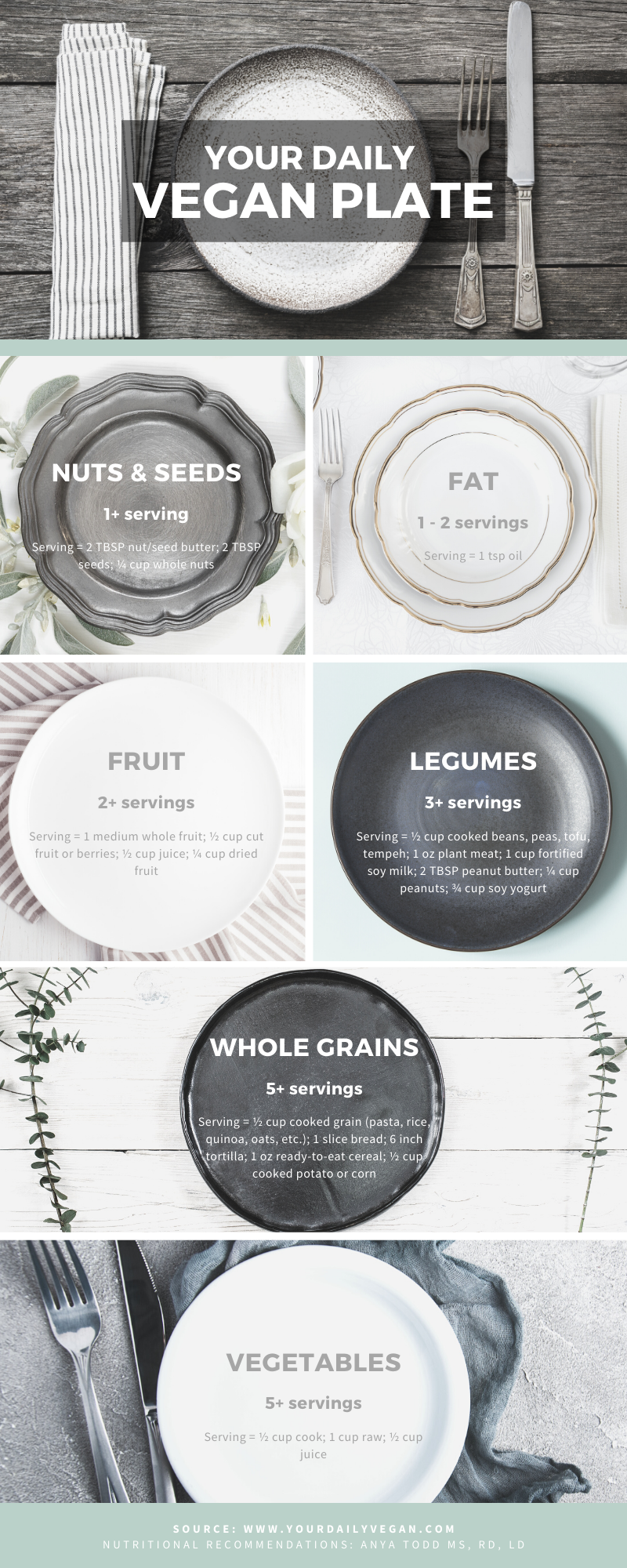
Vegan food
These daily food recommendations are general guidelines and a good starting place when learning how to put together a day’s worth of vegan meals.
In order from most servings per day to least:
- Vegetables (5+ servings): Serving = ½ cup cook; 1 cup raw; ½ cup juice
- Whole grains (5+ servings): Serving = ½ cup cooked grain (pasta, rice, quinoa, oats, etc.); 1 slice bread; 6-inch tortilla; 1 oz ready-to-eat cereal; ½ cup cooked potato or corn
- Legumes (3+ servings): Serving = ½ cup cooked beans, peas, tofu, tempeh; 1 oz plant meat; 1 cup fortified soymilk; 2 TBSP peanut butter; ¼ cup peanuts; ¾ c soy yogurt
- Fruit (2+ servings): Serving = One medium whole fruit; ½ cup cut fruit or berries; ½ cup juice; ¼ cup dried fruit
- Nuts/Seeds (1+ serving): Serving = 2 TBSP nut/seed butter; 2 TBSP seeds; ¼ cup whole nuts
- Fat (1-2 servings): Serving = 1 tsp oil
Fortified foods & Supplements
Todd also recommends including plenty of calcium-rich foods from every group like kale, bok choy, and broccoli; beans; fortified dairy-free milk and juices; whole almonds, tahini, fortified cereals, and many more.
She also recommends supplementing with Vitamin B12 if you’re not consuming two to three fortified foods daily.

Keep and donate piles / Source
First Steps / Vegan Food / Costs / Nutrition / Beyond Food
5. Beyond Food
Veganism goes beyond our plates.
Taking the next steps
Veganism extends beyond our plates and into every other aspect of our lives. There's a lot to know, from obvious animal-based fabrics like leather and fur to the hidden animal bits in health and beauty products.
Once you're comfortable, get started removing animals from all of the other areas of your life.
Because veganism is big with many things to know, I decided to put together a library of information designed to help you navigate it.
Save animals one meal, one outfit, and one refusal to visit a zoo or circus at a time.
These vegan living guides will show you how.
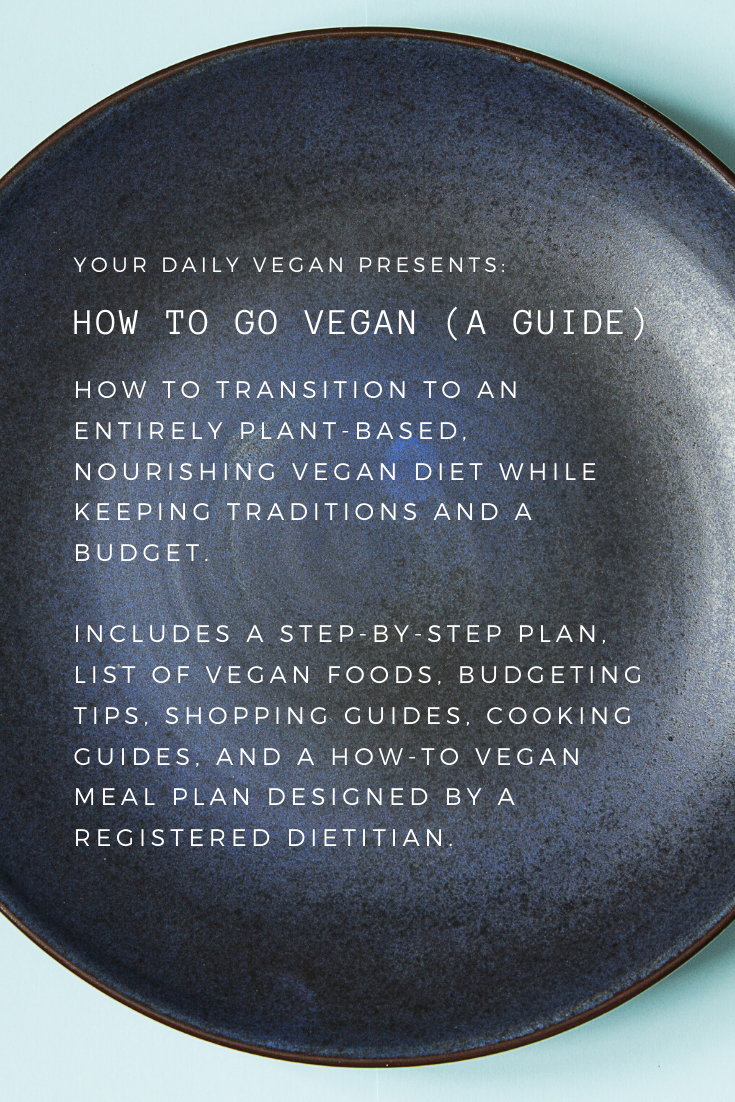
Truth in advertising
I am committed to providing accurate information to the vegan community. Meticulously researched, the topic explored in this guide contains the information available at the time of publishing.
I don’t just say it; I source it too.
Please contact me if you find incorrect data.

